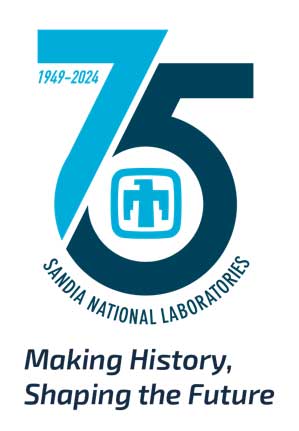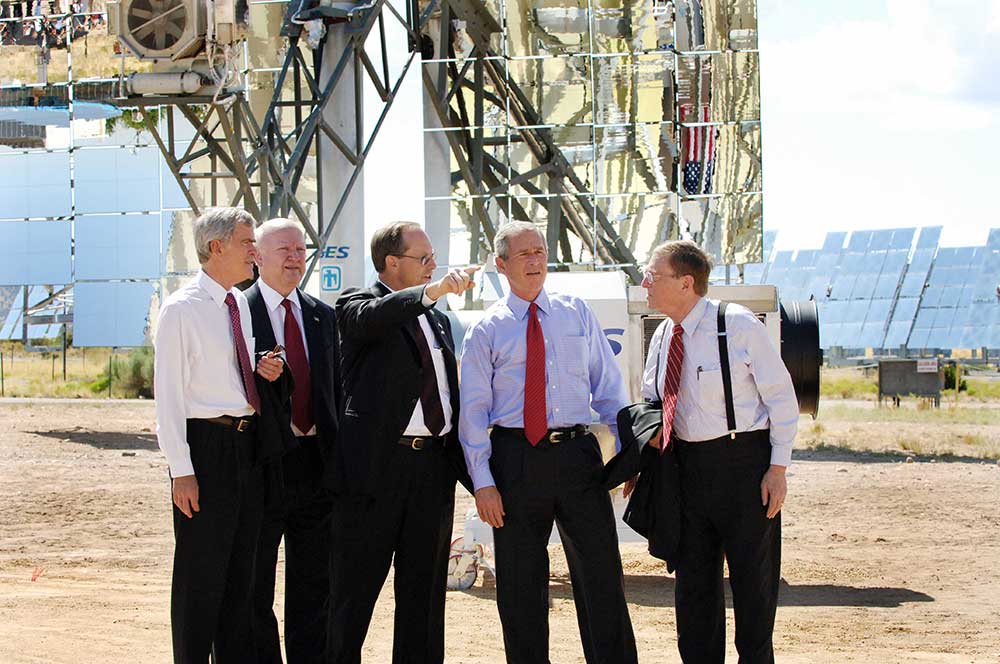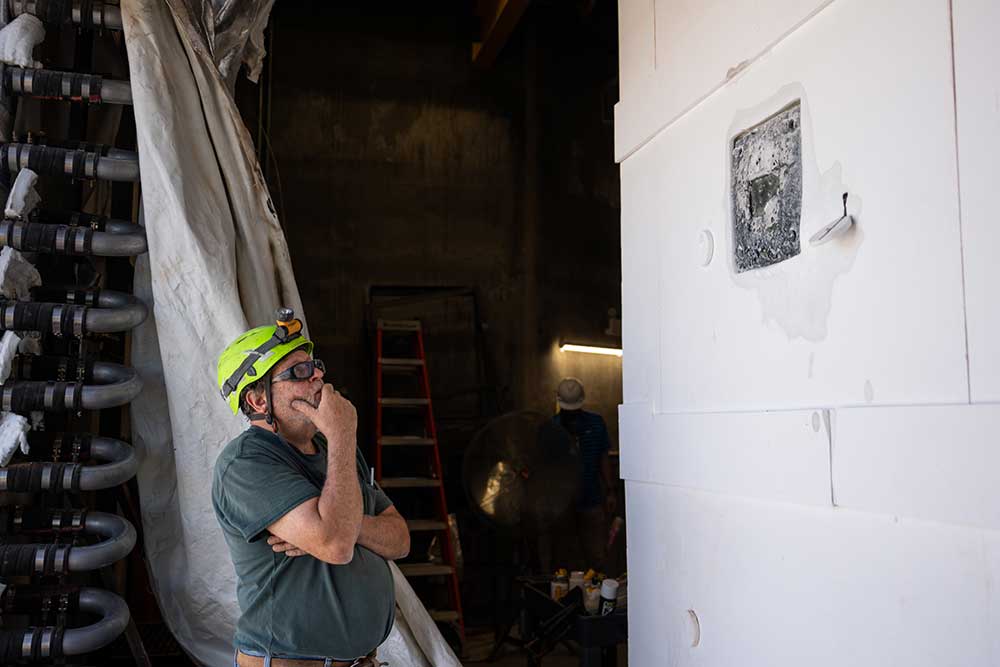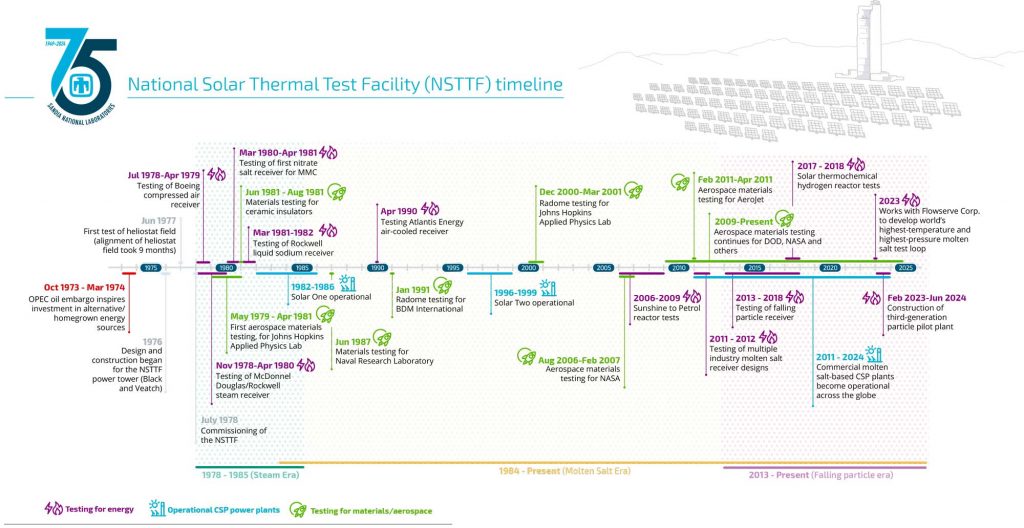National Solar Thermal Test Facility plays important role in multiple missions


What do steam, salt and sand have in common? All three have been studied by researchers at the National Solar Thermal Test Facility in their quest to shed light on innovative ways to harness concentrated sunlight for utility-scale electricity.
Commissioned in July 1978, the NSTTF has played a vital role in the development of concentrating solar power technologies and served as a testing ground for aerospace and defense applications, areas it continues to advance today.
Its development was prompted by the OPEC oil embargo of 1973 and was inspired by early solar dish testing in White Cliffs, Australia, and legends of Archimedes’ heat ray, said Ken Armijo, a concentrating solar power researcher at Sandia and project leader of a digital concentrating solar power archive.
“The NSTTF has a unique place in Sandia’s history,” said Margaret Gordon, manager of the concentrating solar technologies group. “We’ve hosted so many visitors — U.S. presidents, secretaries of energy, congresspeople — and been able to emphasize the engineering expertise that exists at Sandia, not just the NSTTF but the Labs as a whole. We are the scientists and engineers who make things work, not just for renewable energy but for defense and other applications.”
Over the years, the NSTTF has been involved in testing solar dishes, parabolic troughs to concentrate sunlight into a line, as well as the very visible 200-foot-tall power tower with a field of more than 200 mirrored heliostats, Ken said. Researchers found that while the initial cost of a power tower and heliostat field was greater, over the lifetime of a plant, the levelized cost of electricity was lower than the more modular forms of concentrating solar power, he added.
Steam and salt
In the early years, researchers focused on concentrating sunlight on an array of metal tubes containing water, so that the heat from the sun could turn the water into steam, which in turn could spin a turbine to generate electricity. Until 1985, Sandia’s power tower produced up to five megawatts of energy for the grid using this method and a generator salvaged from the USS Norfolk, a post-World War II warship, Ken said.

In 1981, Sandia worked with the company Rocketdyne to design and build a 300-foot-tall power tower with a 360-degree heliostat field in Barstow, California, called Solar One. Solar One produced 10 megawatts of electricity from 1982 to 1986.
Transitioning in 1986, the NSTTF switched its research focus from steam to molten nitrate salts. Molten salt — salt that is heated to approximately 1,000 degrees Fahrenheit so it flows like a liquid — can hold a lot more heat than steam and can be stored in tanks to allow a power plant to continue to produce power at night or during cloudy periods, Ken said. However, molten salt is quite corrosive, requiring pipes, valves and seals to be made from non-corrosive materials that also can withstand the heat. Conversely, if the salt gets too cool, it freezes and can really gum up the works, he added.
“We were one of the powerhouses of molten salt research for two decades,” Ken said. “Sandia and Plataforma Solar de Almeria in Spain were the places to do molten salt research for CSP.”
Collaborating with the Southern California Edison Company in 1995, the second-largest electric utility in the nation at the time, Sandia converted Solar One to molten salt using the lessons learned from the NSTTF. Solar Two operated from 1996 to 1999, produced 10 megawatts of electricity annually and could store hot salt for up to three hours.
Sandia’s expertise in molten salt continues to this day with the world’s largest molten salt test loop, Ken said. This series of three loops is constructed from 6-inch pipes and can test molten nitrate salts from 570 to 1,085 degrees Fahrenheit. Innovations and improvements from this facility are used at dozens of molten-salt-based concentrating solar power plants around the world as well as molten-salt-based advanced nuclear reactors, he added.
Aerospace materials testing
Since 1979, the NSTTF has been a vital hub for testing aerospace materials for NASA, the DOD and private industry, Ken said.

(Photo by Craig Fritz)
The facility can replicate the intense heat of reentering the atmosphere, while being a more cost-effective method of testing materials and subsystems than an Arc jet, Ken said. Arc jet testing costs $100,000 per shot, while testing on the power tower costs $21,000 per day, he said.
The various NSTTF labs have been involved in testing space shuttle tiles, sensors and communication systems to see if they would work during reentry. The facilities have also been involved testing nose cones for space shuttles and planes, and aerospace materials’ resilience to rapid temperature changes.
The power tower and heliostat field can produce light intensities up to 3,500 suns. The solar furnace, a fixed solar dish, can produce light intensities up to 10,000 suns, resulting in temperatures up to 5,400 degrees Fahrenheit, Ken said. The NSTTF also has a high-intensity solar simulator that allows for continuous, long-term testing of materials.
Additionally, the test bay 140 feet up on the power tower has a wind tunnel capable of mimicking the conditions of Mach 0.3. Ken added he would like to get funding to build a Mach 1 or Mach 5 wind tunnel on top of the tower to replicate even better the intense conditions of reentry.
Testing materials for aerospace applications continues to this day. Researchers from Johns Hopkins University Applied Physics Laboratory tested heat-shield materials for possible solar-powered rockets on the power tower in 2022. In 2023, NASA tested materials at the tower for the Mars Sample Return mission.
Sand like particles
From 2013 to 2018, Sandia researchers led by Cliff Ho explored the potential of sand like particles in collecting heat from concentrated sunlight. Unlike molten salt, cold particles flow just as well as hot particles and can be stored for long periods of time. Also, the dark, ceramic particles can reach temperatures of 1,800 degrees Fahrenheit or hotter, compared to molten salt’s 1,000 degrees. Higher temperatures mean better heat-to-electricity conversion.
Particles require different systems than water or liquid salt to transport and imbue them with heat from concentrated sunlight. Therefore, much of the effort to design and test a falling-particle receiver that produced a smooth curtain of particles was focused on mitigating conversion and transportation risks.
In 2021, the falling-particle receiver efforts were recognized by DOE, with the team receiving $25 million to build a third-generation concentrating solar power pilot plant to pave the way for widespread commercialization. The Sandia team hopes to show that the plant can heat particles above 1,300 degrees Fahrenheit, store them for at least six hours, and produce 500 kilowatts of power though integration with a supercritical carbon dioxide Brayton cycle.
Construction of the particle pilot plant tower should be complete by June 2024, with equipment installation and testing in the subsequent months. While based in New Mexico, the particle pilot plant project involves academic and industry collaborators from across the world.

The future of concentrating solar power
“There are three main areas where we think solar thermal technologies have the ability to grow in the future,” Margaret said. “The first is industrial process heat, using this high-quality, high-temperature heat that particle-based technologies can produce to replace natural gas and other fossil fuels for industrial processes like making cement or making transportation fuels. The second is in long-duration energy storage. Thermal energy storage is inherent to concentrating solar systems. The third one is around large-scale electricity production. The grid needs some amount of steady electricity generation, and CSP, nuclear power and geothermal energy are the best carbon-free sources for this ‘baseload’ power.”
Sandia researchers are collaborating with private companies to explore concentrating solar thermal energy for making clinker, a key component in cement, while also capturing the carbon dioxide produced as part of the chemical process, Margaret said. Using electricity, which could come from other green sources, poses a significant challenge for reaching the very high temperatures needed for the process.
Sandia scientists are studying how to use solar thermal chemistry to make green fuels such as ammonia, hydrogen and syngas in a renewable way, she said. Researchers have also looked at the environmental, benefits and taste improvements of replacing natural gas or propane with solar power for roasting foodstuffs.
While some existing concentrating solar power plants have enough thermal energy storage to last overnight, Sandia computer modeling of particle-based solar power has shown the potential for next-generation plants to store more than 100 hours of heat in a cost-effective manner, Margaret said. This breakthrough could be used to meet electricity demands when the sun isn’t shining and the wind isn’t blowing, greatly increasing the resiliency and reliability of the national grid.
“We think that the particle pilot plant is going to do for particles what Solar Two did for molten salt,” Margaret said. “The engineering that Sandia did for Solar Two and molten salt exists in all molten salt plants around the world. Proving out base technologies and reducing risks associated with those components — we think can do the same thing for particles.”